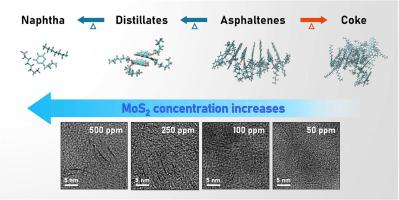Journal of Industrial and Engineering Chemistry ( IF 5.9 ) Pub Date : 2021-07-04 , DOI: 10.1016/j.jiec.2021.06.033 Ngoc Thuy Nguyen 1 , Ki Hyuk Kang 1 , Hai Hung Pham 2 , Kang Seok Go 2 , Duy Van Pham 1 , Pill Won Seo 1 , Nam Sun Nho 2 , Chul Wee Lee 3 , Sunyoung Park 1

|
Slurry phase hydrocracking of vacuum residue at various catalyst concentrations was performed in a semi-batch reactor to investigate the effect of catalyst concentration on the reaction performance. The secondary cracking reaction was dominant at high-residue conversion (>60 wt%) without the catalyst but it was suppressed by the catalyst. Moreover, the conversion of asphaltenes at high-residue conversions was found to be dependent on the catalyst concentration. At low catalyst concentrations (0–100 ppm), asphaltenes were converted to light products at low-residue conversions and to coke at high-residue conversions. At high catalyst concentrations (100–500 ppm), asphaltenes were mainly converted to light products even at high conversions. Based on the experimental results, equations for the onset of coke formation with respect to the catalyst concentration were proposed. The higher the catalyst concentration, the longer was the coke induction period. A kinetic model was also proposed, and the experimental data could be predicted well using the same. The transformation of residue to coke was dominant in the non-catalytic hydrocracking and the coke formation rate significantly decreased as the catalyst concentration increased.
中文翻译:

半间歇式反应器减压渣油催化加氢裂化:催化剂浓度对沥青质转化率和产物分布的影响
在半间歇式反应器中进行了不同催化剂浓度下减压渣油的淤浆相加氢裂化,以研究催化剂浓度对反应性能的影响。在没有催化剂的情况下,二次裂化反应在高残留转化率(> 60 wt%)时占主导地位,但被催化剂抑制。此外,发现高残留转化率下的沥青质转化率取决于催化剂浓度。在低催化剂浓度(0-100 ppm)下,沥青质以低残留转化率转化为轻质产品,以高残留转化率转化为焦炭。在高催化剂浓度(100-500 ppm)下,即使在高转化率下,沥青质也主要转化为轻质产品。根据实验结果,提出了与催化剂浓度相关的焦炭形成开始的方程。催化剂浓度越高,焦炭诱导期越长。还提出了动力学模型,利用该模型可以很好地预测实验数据。在非催化加氢裂化过程中,渣油向焦炭的转化占主导地位,随着催化剂浓度的增加,焦炭形成率显着降低。











































 京公网安备 11010802027423号
京公网安备 11010802027423号